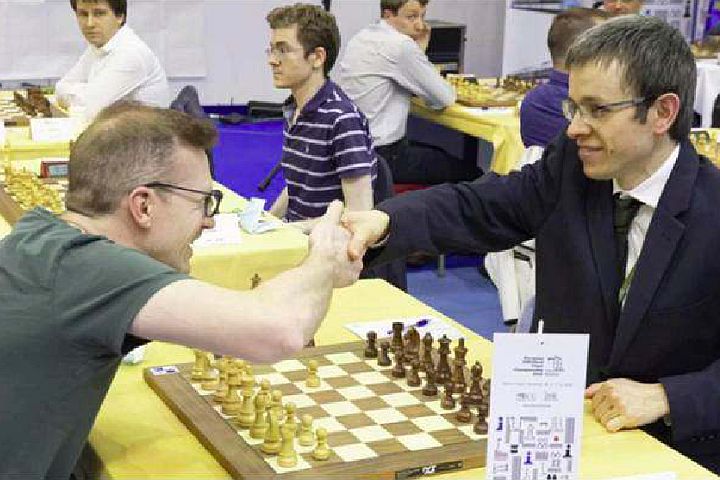
By: IA Tamas Gyomber
First of all, let’s see what our bread & butter, the FIDE Handbook says about threefold repetitions:
9.2 The game is drawn, upon a correct claim by a player having the move, when the same position for at least the third time (not necessarily by a repetition of moves):
9.2.1 is about to appear, if he/she first indicates his/her move, which cannot be changed, by writing it on the paper scoresheet or entering it on the electronic scoresheet and declares to the arbiter his/her intention to make this move, or
9.2.2 has just appeared, and the player claiming the draw has the move.
9.2.3 Positions are considered the same if and only if the same player has the move, pieces of the same kind and colour occupy the same squares and the possible moves of all the pieces of both players are the same. (...)
9.3 The game is drawn, upon a correct claim by a player having the move, if:
9.3.1 he/she indicates his/her move, which cannot be changed, by writing it on the paper scoresheet or entering it on the electronic scoresheet and declares to the arbiter his/her intention to make this move which will result in the last 50 moves by each player having been made without the movement of any pawn and without any capture, or 9.3.2 the last 50 moves by each player have been completed without the movement of any pawn and without any capture.
In the following section TFR (threefold repetition) can also be understood as 50-moves rule as the general handling ways are identical for them.
So let’s begin! There are two different ways to claim a TFR, in the player’s own move:
- The same position is already on the board third time, caused by the last move of the claimant’s opponent. The explanation in parenthesis at the end of 9.2 is very important – I’ve just met a player who firmly believed that threefold repetition can only be claimed if it appeared in the latest moves, with both players making the same moves (repetition).
- With the claimant’s NEXT MOVE, the TFR comes to be. It’s a bit trickier as there are a few things the claimant can do to make the claim invalid. We’ll soon take a look at these cases.
Way (1) is simple: the claimant may pause the chessclock and call the arbiter, claiming the draw based on the position on the board. Arbiters, please don’t forget to stop the clock if the player didn’t do it before summoning you! In way (2) however, there are a few things that can go wrong. First of all: many players just forget to write down their next move on their scoresheet. Without this the claim is not valid.
The second one should also be obvious, but I had 2 cases in the recent past where title holders weren’t aware of this – and on an arbiters’ test many gave the wrong answer to this question. According to article 9.4, if the player touches a piece as in Article 4.3, he/she loses the right to claim a draw under Article 9.2 or 9.3 on that move.
I had two cases, also in the recent past, when I had to declare claims invalid due to this. In the first one, the player already made the move on the board when he summoned me to claim the draw. In the second one, he didn’t make it, but when I arrived at the board, he picked up his knight and showed me that he’s about to make this move, and it will be a TFR after this. I had to decline both claims because of their actions.
In situations where the claim is invalid due to some formal error, I tell the player ‘sorry, but this is not the correct way to claim a draw on threefold repetition’. At this point most players usually ask back: what is it then? And you’re allowed to explain them, as art. 11.9 says: A player shall have the right to request from the arbiter an explanation of particular points in the Laws of Chess.
In case of a valid claim however, there are a few things you can do to make your life easier. First of all, ask the opponent if he agrees that there’s indeed a TFR. If he does, there’s nothing more to do than registering the result. If he doesn’t agree, you can still remind him that the claim itself is considered also as an offer of a draw. It happened to me multiple times that after this the opponent agreed, and they shook hands. (*If Sofia rules apply and they haven't reached the required number of moves, you need to check the claim in any case).
If the opponent wants to play on however, as it was written in an earlier article by IA Tomasz Delega, make sure that both players go with you either to the computer assigned to broadcasting the games, or to a separate board, reconstructing the game together under your supervision. A player shouldn’t be allowed to just sit at the board and analyse the position when the clock is stopped.
In case the claim was incorrect, don’t forget to give 2 minutes of extra time to the claimant’s opponent (it’s mandatory), and if the claim was based on an intended move, ask the player to make it (assuming that it’s legal of course).
I hope that I could help a bit in understanding these crucial parts of the regulations. In a future article a few examples will be presented to shed more light on them.
The above article appeared in the ECU E-Magazine, January 2023. The magazine can be read online together with interactive links on the following link, or it can be downloaded from the ECU Website.
























